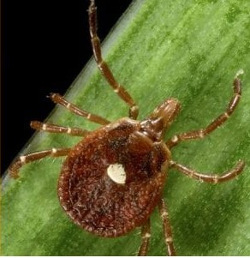By Tim McDermott
Livestock producers have had a lot on their plates lately. The weather including constant rain has damaged pasture as well as made timely hay making difficult. While I do not want to add to this list of worries, I want to make sure to educate producers that there is a new-ish tick concern that can dramatically affect the lifestyle of a producer of swine, cattle and small ruminants. Over the last decade we have seen an increase both in the spread of new tick species into our region as well as new diseases and allergic syndromes that can be vectored to producers from these invasive species. Lyme disease was seldomly diagnosed over ten years ago and has now become commonplace with the spread of the Black Legged (Deer) Tick. Viral diseases vectored to humans that had not been found before outside of Asia are now being diagnosed with increasing regularity in the United States. Today we are going to discuss an allergic syndrome that a producer can develop after getting bitten by a fairly new to the Midwest tick invader.

The Lone Star Tick, a tick species that entered Ohio over the last decade, has become known for causing an allergic syndrome in people called Mammalian Muscle Allergy.
The Lone Star Tick (Amblyomma americanum) is a tick species that entered Ohio over the last decade from the south and has spread now through out the state. It is an aggressive feeder of producers, livestock and companion animals. It prefers a wooded habitat but can also be found along the perimeter of pasture and hay fields extending into the grass in many cases. This tick is a known vector for many bacterial and viral diseases but is not known for transmitting Lyme disease. What it has become known for is an allergic syndrome called galactose alpha–1,3-galactose (alpha gal) allergy, better known as Mammalian Muscle Allergy. If a human is bitten by the Lone Star Tick and has an allergic reaction to the alpha-gal carbohydrate in the tick saliva, they can show food allergy symptoms including hives, itching, nausea, vomiting, diarrhea and swelling after eating mammalian muscle such as pork, beef, lamb and venison. In severe cases, the individual may suffer anaphylactic shock. One unusual presentation of this allergy is that while most food allergies will cause the person to suffer symptoms soon after eating the food, mammalian muscle allergy commonly does not cause the allergic symptoms in the affected person for several hours after ingesting meat. This delayed onset of symptoms can make diagnosis challenging in many cases. The only way to prevent these symptoms is to abstain from mammalian meat by switching to fish, chicken or vegetable-based proteins. It is not completely known how long this allergy lasts within the individual. Scientists are studying this syndrome to determine the exact cause of the allergy and if more than just the Lone Star Tick is a suspect.
It is difficult to imagine how this would change the lifestyle of a livestock producer to not be able to ingest meat from the animals they raise without suffering from allergic symptoms than can become quite severe. How does a producer go about protecting themselves and their families? The goal with any tick-vectored disease or allergy is to prioritize not getting bitten at all. Wearing long sleeves, long pants and boots that have been treated with permethrin has shown to help prevent tick bites. Checking for ticks after working outside to detect them before attachment should be prioritized. Work with your veterinarian to develop a tick preventative protocol for your companion animals to prevent ticks entering the house on your dogs or cats. Finally, if you think you may have been exposed to a tick bite or show symptoms of alpha-gal allergy, contact your physician right away to get a diagnosis.